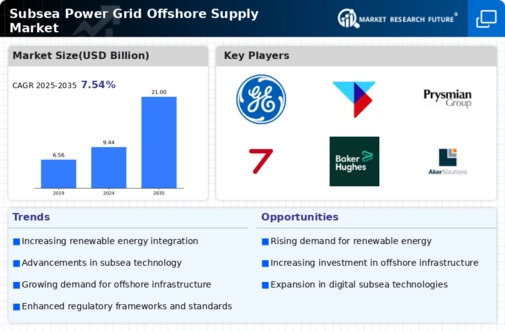Increasing Energy Demand
The rising The Subsea Power Grid Offshore Supply Industry. As economies expand and populations grow, the need for reliable and sustainable energy sources intensifies. This demand is particularly pronounced in offshore oil and gas sectors, where subsea power grids facilitate efficient energy distribution. According to recent estimates, energy consumption is projected to increase by approximately 30 percent by 2040, necessitating innovative solutions like subsea power grids. These systems not only enhance energy efficiency but also reduce operational costs, making them attractive to energy producers. Consequently, the Subsea Power Grid Offshore Supply Market is likely to experience substantial growth as stakeholders seek to meet this escalating energy demand.
Advancements in Subsea Technology
Technological innovations are transforming the Subsea Power Grid Offshore Supply Market. Recent advancements in subsea cable technology, power electronics, and monitoring systems have significantly improved the efficiency and reliability of subsea power grids. For instance, the development of high-voltage direct current (HVDC) technology allows for the transmission of electricity over long distances with minimal losses. This is particularly beneficial for offshore wind farms, which are increasingly being integrated into the energy mix. The market for subsea power systems is expected to grow at a compound annual growth rate of around 10 percent over the next five years, driven by these technological enhancements. As a result, the Subsea Power Grid Offshore Supply Market is poised for expansion, attracting investments and fostering innovation.
Investment in Offshore Infrastructure
Investment in offshore infrastructure is a significant driver for the Subsea Power Grid Offshore Supply Market. As countries seek to enhance their energy security and diversify their energy sources, substantial capital is being allocated to develop offshore energy projects. This includes the construction of subsea power grids that connect offshore renewable energy installations to onshore grids. Recent reports suggest that investments in offshore wind energy alone could exceed 200 billion dollars by 2030, underscoring the financial commitment to this sector. Such investments not only bolster the Subsea Power Grid Offshore Supply Market but also create opportunities for technological advancements and job creation. As a result, the market is expected to thrive in response to this influx of capital.
Focus on Sustainability and Environmental Impact
The growing emphasis on sustainability and minimizing environmental impact is significantly influencing the Subsea Power Grid Offshore Supply Market. Stakeholders are increasingly aware of the ecological implications of energy production, leading to a shift towards cleaner energy solutions. Subsea power grids facilitate the integration of renewable energy sources, such as offshore wind and tidal energy, into existing power systems. This transition is essential for reducing carbon emissions and achieving climate goals. Recent studies indicate that the offshore renewable energy sector could contribute to a reduction of up to 50 percent in greenhouse gas emissions by 2050. Consequently, the Subsea Power Grid Offshore Supply Market is likely to see heightened demand as companies strive to align with sustainability objectives.
Regulatory Frameworks Supporting Offshore Energy
The establishment of supportive regulatory frameworks is a crucial driver for the Subsea Power Grid Offshore Supply Market. Governments are increasingly recognizing the importance of offshore energy sources in achieving energy transition goals. Policies promoting renewable energy, such as offshore wind and solar, are being implemented to encourage investment in subsea power infrastructure. For example, several countries have set ambitious targets for renewable energy generation, which necessitates the development of robust subsea power grids. This regulatory support not only enhances market confidence but also stimulates technological advancements within the industry. As a result, the Subsea Power Grid Offshore Supply Market is likely to benefit from increased investments and project approvals, fostering a conducive environment for growth.

















Leave a Comment